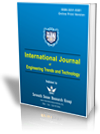Effect of Metal Oxide Nano Liquid on Diesel/Plastic Oil Mixture Diesel Engine Performance
Effect of Metal Oxide Nano Liquid on Diesel/Plastic Oil Mixture Diesel Engine Performance |
||
 |
 |
|
| © 2025 by IJETT Journal | ||
| Volume-73 Issue-2 |
||
| Year of Publication : 2025 | ||
| Author : J. Senthil, M. Prabhahar, C. Thiagarajan, S. Nallusamy, S. Prakash |
||
| DOI : 10.14445/22315381/IJETT-V73I2P114 | ||
How to Cite?
J. Senthil, M. Prabhahar, C. Thiagarajan, S. Nallusamy, S. Prakash, "Effect of Metal Oxide Nano Liquid on Diesel/Plastic Oil Mixture Diesel Engine Performance," International Journal of Engineering Trends and Technology, vol. 73, no. 2, pp. 166-176, 2025. Crossref, https://doi.org/10.14445/22315381/IJETT-V73I2P114
Abstract
This experimental study examines how it affects a diesel engine's combustion, emissions, and performance. Investigators have identified that plastic trash poses a considerable threat to the ecology. It is imperative to effectively mitigate plastic waste, as the increasing population correlates with a rise in plastic refuse. This study evaluates the performance properties of diesel in comparison to a 20% blend of LDPO20 and manganese oxide nanofluids at dosages of 50ppm, and 100ppm. Plastic oil was generated via pyrolysis, and its fuel properties, fatty acid composition, and presence of useful compounds were evaluated experimentally. Chemical methods are employed to synthesise manganese dioxide. Using an ultrasonicator and Tween 20 surfactant, to mix LPO20 and MnO nanofluid equally. The fuel's igniting capabilities were enhanced by the augmentation of nanoparticles, which increased the ratio of surface area to actual volume. The results indicated that a combination of plastic oil improves BTE and reduces BSFC. The testing findings indicated that nanofluids reduced NOx emissions, HC, CO emissions, and smoke compared to LDPO20. The goal is to achieve a uniform combination of LPO20 and MnO nanofluid using an ultrasonicator and Tween 20 surfactant.
Keywords
Plastic pyrolysis oil, Nanofluid, Performance, Manganese Oxide, Diesel engine.
References
[1] M. Mani, C. Subash, and G. Nagarajan, “Performance, Emission and Combustion Characteristics of a DI Diesel Engine Using Waste Plastic Oil,” Applied Thermal Engineering, vol. 29, no. 13, pp. 2738-2744, 2009.
[CrossRef] [Google Scholar] [Publisher Link]
[2] S. Murugan, M.C. Ramaswamy, and G. Nagarajan, “The Use of Tyre Pyrolysis Oil in Diesel Engines,” Waste Management, vol. 28, no. 12, pp. 2743-2749, 2008.
[CrossRef] [Google Scholar] [Publisher Link]
[3] S. Murugan, M.C. Ramaswamy, and G. Nagarajan, “Performance, Emission and Combustion Studies of a DI Diesel Engine Using Distilled Tyre Pyrolysis Oil-Diesel Blends,” Fuel Processing Technology, vol. 89, no. 2, pp. 152-159, 2008.
[CrossRef] [Google Scholar] [Publisher Link]
[4] Ioannis Kalargaris, Guohong Tian, and Sai Gu, “Combustion, Performance and Emission Analysis of a DI Diesel Engine Using Plastic Pyrolysis Oil,” Fuel Processing Technology, vol. 157, pp. 108-115, 2017.
[CrossRef] [Google Scholar] [Publisher Link]
[5] Viswanath K. Kaimal, and P. Vijayabalan, “A Study on Synthesis of Energy Fuel from Waste Plastic and Assessment of its Potential as an Alternative Fuel for Diesel Engines,” Waste Management, vol. 51, pp. 91-96, 2016.
[CrossRef] [Google Scholar] [Publisher Link]
[6] S. Ananthakumar, S. Jayabal, and P. Thirumal, “Investigation on Performance, Emission and Combustion Characteristics of Variable Compression Engine Fuelled with Diesel, Waste Plastics Oil Blends,” Journal of the Brazilian Society of Mechanical Sciences and Engineering, vol. 39, pp. 19-28, 2017.
[CrossRef] [Google Scholar] [Publisher Link]
[7] J. Devaraj, Y. Robinson, and P. Ganapathi, “Experimental Investigation of Performance, Emission and Combustion Characteristics of Waste Plastic Pyrolysis Oil Blended with Diethyl Ether Used as Fuel for Diesel Engine,” Energy, vol. 85, pp. 304-309, 2015.
[CrossRef] [Google Scholar] [Publisher Link]
[8] Sachin Kumar et al., “Performance and Emission Analysis of Blends of Waste Plastic Oil Obtained by Catalytic Pyrolysis of Waste HDPE with Diesel in a CI Engine,” Energy Conversion and Management, vol. 74, pp. 323-331, 2013.
[CrossRef] [Google Scholar] [Publisher Link]
[9] Ceyla Güngör et al., “Engine Performance and Emission Characteristics of Plastic Oil Produced from Waste Polyethylene and its Blends with Diesel Fuel,” International Journal of Green Energy, vol. 12, no. 1, pp. 98-105, 2015.
[CrossRef] [Google Scholar] [Publisher Link]
[10] Viswanath K. Kaimal, and P. Vijayabalan, “A Detailed Study of Combustion Characteristics of a DI Diesel Engine Using Waste Plastic Oil and its Blends,” Energy Conversion and Management, vol. 105, pp. 951-956, 2015.
[CrossRef] [Google Scholar] [Publisher Link]
[11] P. Senthilkumar, and G. Sankaranarayanan, “Effect of Jatropha Methyl Ester on Waste Plastic Oil Fueled DI Diesel Engine,” Journal of the Energy Institute, vol. 89, no. 4, pp. 504-512, 2016.
[CrossRef] [Google Scholar] [Publisher Link]
[12] Ioannis Kalargaris, Guohong Tian, and Sai Gu, “Influence of Advanced Injection Timing and Fuel Additive on Combustion, Performance, and Emission Characteristics of a DI Diesel Engine Running on Plastic Pyrolysis Oil,” Journal of Combustion, vol. 2017, pp. 1-9, 2017.
[CrossRef] [Google Scholar] [Publisher Link]
[13] Miqdam Tariq Chaichan, Abdul Amir H. Kadhum, and Ahmed A. Al-Amiery, “Novel Technique for Enhancement of Diesel Fuel: Impact of Aqueous Alumina Nano-Fluid on Engine’s Performance and Emissions,” Case Studies in Thermal Engineering, vol. 10, pp. 611-620, 2017.
[CrossRef] [Google Scholar] [Publisher Link]
[14] M. Venkata Ramanan, and D. Yuvarajan, “Emission Analysis on the Influence of Magnetite Nanofluid on Methyl Ester in Diesel Engine,” Atmospheric Pollution Research, vol. 7, no. 3, pp. 477-481, 2016.
[CrossRef] [Google Scholar] [Publisher Link]
[15] D. Yuvarajan et al., “Experimental Investigation on the Influence of Titanium Dioxide Nano Fluid on Emission Pattern of Biodiesel in a Diesel Engine,” Atmospheric Pollution Research, vol. 9, no. 1, pp. 47-52, 2018.
[CrossRef] [Google Scholar] [Publisher Link]
[16] Amith Kishore Pandian et al., “Influence of an Oxygenated Additive on Emission of an Engine Fueled with Neat Biodiesel,” Petroleum Science, vol. 14, no. 4, pp. 791-797, 2017.
[CrossRef] [Google Scholar] [Publisher Link]
[17] Ali Keskin, Metin Gürü, and Duran Altıparmak, “Influence of Tall Oil Biodiesel with Mg and Mo based Fuel Additives on Diesel Engine Performance and Emission,” Bioresource Technology, vol. 99, no. 14, pp. 6434-6438, 2008.
[CrossRef] [Google Scholar] [Publisher Link]
[18] Harish Kumar Patel, and Saurabh Kumar, “Experimental Analysis on the Performance of Diesel Engine Using a Mixture of Diesel and Bio-Diesel as a Working Fuel with Aluminium Oxide Nanoparticle Additive,” Thermal Science and Engineering Progress, vol. 4, pp. 252-258, 2017.
[CrossRef] [Google Scholar] [Publisher Link]
[19] Syed Javed et al., “Effect of a Zinc Oxide Nanoparticle Fuel Additive on the Emission Reduction of a Hydrogen Dual-Fuelled Engine with Jatropha Methyl Ester Biodiesel Blends,” Journal of Cleaner Production, vol. 137, pp. 490-506, 2016.
[CrossRef] [Google Scholar] [Publisher Link]
[20] Muthusamy Sivakumar et al., “Effect of Aluminium Oxide Nanoparticles Blended Pongamia Methyl Ester on Performance, Combustion and Emission Characteristics of Diesel Engine,” Renewable Energy, vol. 116, pp. 518-526, 2018.
[CrossRef] [Google Scholar] [Publisher Link]
[21] D. Damodharan et al., “Combined Influence of Injection Timing and EGR on Combustion, Performance and Emissions of DI Diesel Engine Fueled with Neat Waste Plastic Oil,” Energy Conversion and Management, vol. 161, pp. 294-305, 2018.
[CrossRef] [Google Scholar] [Publisher Link]
[22] Elsa Cherian, Arya Rajan, and G. Baskar, “Synthesis of Manganese Dioxide Nanoparticles Using Co-Precipitation Method and its Antimicrobial Activity,” International Journal of Modern Science and Technology, vol. 1, no. 1, pp. 17-22, 2016.
[Google Scholar] [Publisher Link]
[23] A. Prabu, and R.B. Anand, “Emission Control Strategy by Adding Alumina and Cerium Oxide Nanoparticle in Biodiesel,” Journal of the Energy Institute, vol. 89, no. 3, pp. 366-372, 2016.
[CrossRef] [Google Scholar] [Publisher Link]

